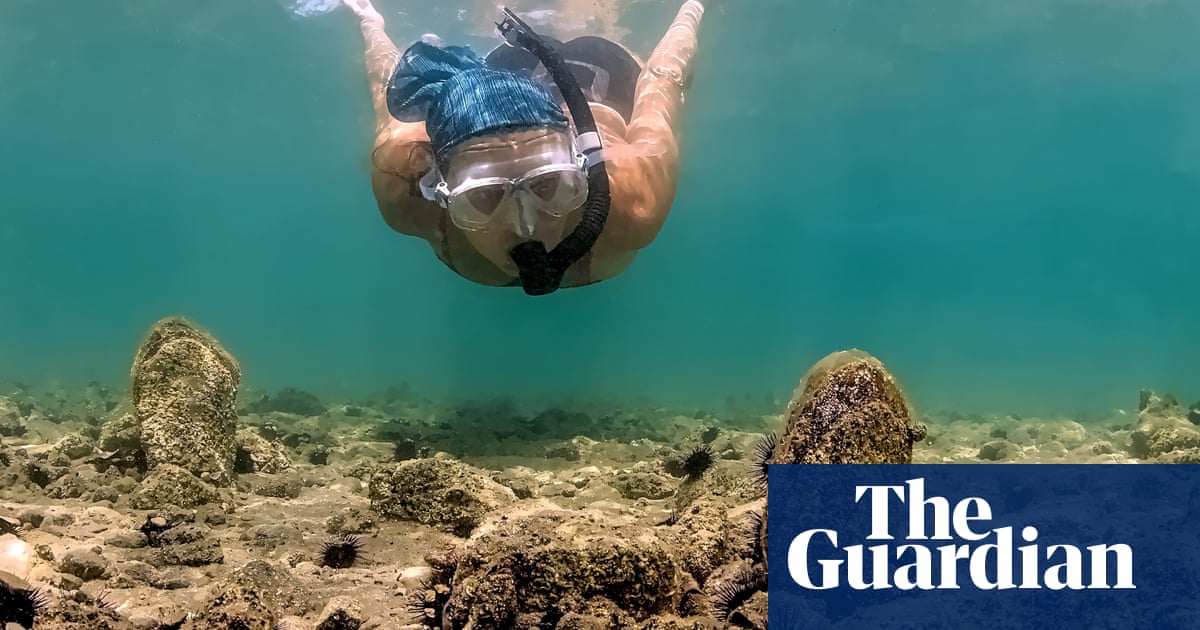I swim and I stare as my shadow causes panic on the seabed below. Shells snap shut, one, two, three. Alive, alive, alive. I am so happy to see them: noble pen shells, all improbably but indisputably alive. These giant Mediterranean clams are a species on the verge of extinction, with so few left that it is rare to find one living anywhere in Europe.
Often known as fan mussels, the moniker is a suitable one for this beautiful bivalve, its pearlescent point dug into the sand, fanning up to a rounded posterior. I’m in the Amvrakikos Gulf on the west coast of Greece, where I have the privilege of watching these creatures grow. Their presence is such good news that Spanish scientists have flown in to see the clams for themselves as part of an EU project focused on trying to rescue, and hopefully expand, what is left of the pen shell population.
Given the chance, noble pen shells (Pinna nobilis) can live for 20 years and grow to more than a metre tall. Only the giant clam is bigger. They are endemic to the Mediterranean, increasing water clarity and biodiversity, and their large shells provide habitat for myriad species. As fans of the pen shell know (and I am the biggest fangirl of all), if you approach carefully you might glimpse its habitual guest – a symbiotic shrimp – inside.
Tragically, after a series of mass mortality events that started in Spain, it is more common to find noble pen shells dead than alive.
Humans have exploited these bivalves for centuries, eating the meat and trading their shells. Even the creature’s byssus – the beard-like threads that anchor them to pebbles – were spun for centuries into “sea silk”. But in 2016, their future suddenly became critical. Pinna nobilis began to die in their millions, with 99.9% of the Spanish population wiped out in months.
This was primarily caused by a parasite, Haplosporidium pinnae, which spread everywhere from Spain to Greece, Tunisia to Turkey. In 2019, the IUCN red list upgraded their status to critically endangered after almost all monitored open sea populations were decimated. Of the small populations remaining, most were clinging on in coastal lagoons such as Amvrakikos. But very few had what the scientists call “recruitment” – youngsters.
It is significant, then, that most I see are under 20cm. They’re a beautiful sight – frilly shells, sunlit yellow against green blades of seagrass. Young adults, and healthy too, judging by the speed at which their valves are closing. With youth comes hope.
Orestis Papadakis and Maria Zotou, marine biologists from the University of the Aegean, have spent years surveying the Greek coastline, finding “endless graveyards”, Papadikis says. They found “scattered shells, huge populations gone”.
In Amvrakikos, I watch Papadikis counting the numbers in a large group. “This is the biggest and most important population in the Mediterranean,” he says.
The presence of juveniles is crucial for efforts to repopulate the Mediterranean, which is why scientists across Europe are collaborating through Life Pinnarca, the EU project. Its director, José Tena Medialdea, and project manager, José Rafael García March, join us to help relocate vulnerable individuals.
“This can be the saviour of the species,” García March says of the Amvrakikos population. “If they survive this summer.” They should. According to all measures, this population is healthy, with low mortality and no sign – so far – of the parasite. Humans are the biggest threat here.
The sun is beating hard as we gather in a little bay in the south of the gulf as the daily swimmers arrive. It’s a convivial atmosphere, a familiar Greek scene – local people in hats, backing into the sea. When I look below, at feet bouncing perilously around fan mussels in the shallows, I understand why these individuals need relocating.
I watch Papadakis carefully removing the first clam – byssus intact – while its tenant shrimp flees. Medialdea’s work, meanwhile, is observed closely by a cuttlefish. Cute distractions aside, each mollusc is relocated and tagged.
Meanwhile, in my local bay, tourists have arrived, dozens wading among the most dense population. With trepidation, I swim to the edge of the seagrass meadow. I am dismayed to count dozens smashed around a few survivors. Suddenly the prospect of watching them grow seems less likely than witnessing their destruction.
Accidental damage isn’t the only problem. The surveys found evidence of illegal dredging in the gulf, with catastrophic consequences on pen shell populations, seagrass meadows and other important habitats. Poaching is also rife, with reports of divers plucking larger specimens.
The lack of protection shocks the visiting scientists. In Spain, they say, the pen shells are protected by an environmental branch of the civil guard. Poachers caught harming the species face two years in prison. “Without the poaching and killing, the Amvrakikos colony would have been the big hope.” Now, García March says, “We are afraid of what will happen there.”
But all is not lost, especially if enough conservation-minded local people can get on board. Watching us from a bench are Thanos and Giorgios, two cheerful men in their 70s from a nearby village. On our last visit, Zotou had spoken to the two men about the precarious status of the pen shells, or pinnas. Now, Thanos says, he has told everyone: “Don’t touch the pinnas!”
